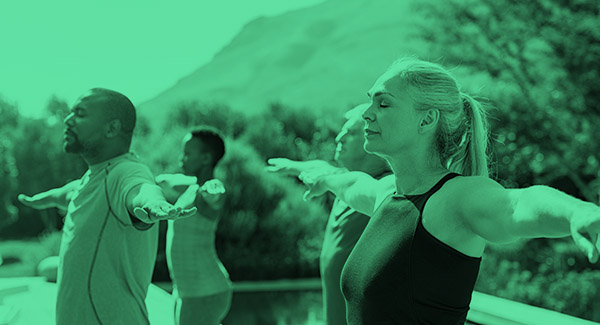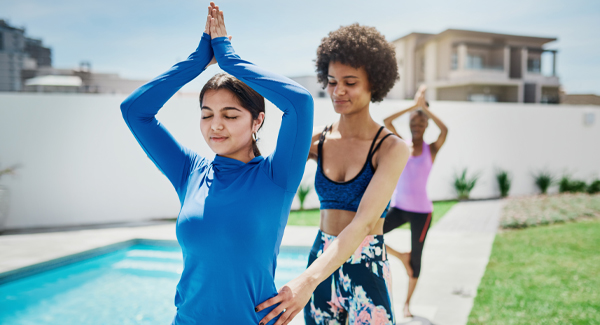Yoga Benefits for Arthritis
Get the details on how practicing yoga regularly can reduce pain, increase flexibility, improve function and lower stress in people with arthritis.
By Susan Bernstein
Yoga is a practice that comes in many different forms, and includes poses, breathing techniques and meditation. It started in ancient India and has been touted as a way to boost physical and mental health for 5,000 years. In fact, yoga is proven to help people with arthritis improve many physical symptoms like pain and stiffness, and psychological issues like stress and anxiety. People with various types of arthritis who practice yoga regularly can reduce joint pain, improve joint flexibility and function, and lower stress and tension to promote better sleep.
Yoga’s Many Benefits
Many people turn to yoga as a way to exercise gently, as well as to reduce tension and improve joint flexibility. Yoga also can help a person with arthritis build muscle strength and improve balance, says Sharon Kolasinski, MD, a professor of clinical medicine and a rheumatologist at the University of Pennsylvania in Philadelphia. In addition, yoga offers people with arthritis a form of exercise that is enjoyable enough to do regularly.
Yoga is a practice that comes in many different forms, and includes poses, breathing techniques and meditation. It started in ancient India and has been touted as a way to boost physical and mental health for 5,000 years. In fact, yoga is proven to help people with arthritis improve many physical symptoms like pain and stiffness, and psychological issues like stress and anxiety. People with various types of arthritis who practice yoga regularly can reduce joint pain, improve joint flexibility and function, and lower stress and tension to promote better sleep.
Yoga’s Many Benefits
Many people turn to yoga as a way to exercise gently, as well as to reduce tension and improve joint flexibility. Yoga also can help a person with arthritis build muscle strength and improve balance, says Sharon Kolasinski, MD, a professor of clinical medicine and a rheumatologist at the University of Pennsylvania in Philadelphia. In addition, yoga offers people with arthritis a form of exercise that is enjoyable enough to do regularly.
Yoga’s Many Benefits
Add variety to your workout
Yoga provides an exercise option. It may not be the only thing you do, but it can be a component of an overall healthy regimen that may also include cardiovascular exercises like walking or biking.
Improve physical function
People with arthritis who practice yoga regularly will eventually see improved physical function. “Yoga can enhance pain management, thereby improving function,” Dr. Kolasinski says.
Improve flexibility
Yoga can also benefit people with stiff joints due to arthritis. Stretching exercises in general help improve range of motion, so the fact that you’re stretching in yoga will help flexibility.
Stay active
On days when you’re experiencing a painful arthritis flare, continuing to do some type of physical activity like yoga, if possible, can help you maintain joint flexibility.
Create a mind-body connection
Yoga’s emphasis on introspective thought – pinpointing the sources of pain or anxiety and learning to relax them – is useful for people with arthritis. In yoga, you develop a communication with your own body.
Yoga for other Conditions
Yoga and Osteoarthritis
Dr. Kolasinski, studied the effects of yoga on people with knee osteoarthritis (OA). She found that people taking 90-minute, modified Iyengar yoga classes once a week for eight weeks reported reductions in pain and improvements in physical function and joint stiffness. Yoga poses were modified and props were used to make the practice accessible to all participants.
“Yoga is definitely one option for people with arthritis. Not only for the exercise benefits, but it’s also beneficial in the mind/body area, promoting relaxation and stress reduction,” says Dr. Kolasinksi.
Still, Dr. Kolasinki warns: “You need to be taught by an instructor who understands your limitations.” Postures should be modified to suit your needs, and props should be used to help you balance during poses. Because it allows the use of aids, Iyengar yoga, in particular, is often recommended for people with arthritis.
A study conducted at the University of Pennsylvania showed that yoga could provide relief for people with hand osteoarthritis, a problem that can impair daily activities like dressing, driving a car or cooking. An eight-week yoga regimen improved hand pain, tenderness and finger range of motion in the participants.
“Yoga is definitely one option for people with arthritis. Not only for the exercise benefits, but it’s also beneficial in the mind/body area, promoting relaxation and stress reduction,” says Dr. Kolasinksi.
Still, Dr. Kolasinki warns: “You need to be taught by an instructor who understands your limitations.” Postures should be modified to suit your needs, and props should be used to help you balance during poses. Because it allows the use of aids, Iyengar yoga, in particular, is often recommended for people with arthritis.
A study conducted at the University of Pennsylvania showed that yoga could provide relief for people with hand osteoarthritis, a problem that can impair daily activities like dressing, driving a car or cooking. An eight-week yoga regimen improved hand pain, tenderness and finger range of motion in the participants.
Yoga and Rheumatoid Arthritis
Subhadra Evans, PhD, a researcher at the University of California at Los Angeles Medical Center conducted a small study of the effects of six weeks of Iyengar yoga on a group of women with rheumatoid arthritis (RA). Evans was impressed by strong results showing yoga’s immediate, positive impact on people with a serious chronic disease.
Participants filled out questionnaires to measure pain, disability, mood, function and other symptoms, and also sat down for personal interviews with the researchers to gauge their feelings about the yoga program and its effects on their RA.
“They all said that day-to-day levels of pain hadn’t changed, but their relationship to the pain had changed. They were able to get through daily activities much more effectively, and had much more energy,” Evans says. “I think if we had had them do yoga longer, we may have seen more significant changes in pain and other symptoms.”
Participants filled out questionnaires to measure pain, disability, mood, function and other symptoms, and also sat down for personal interviews with the researchers to gauge their feelings about the yoga program and its effects on their RA.
“They all said that day-to-day levels of pain hadn’t changed, but their relationship to the pain had changed. They were able to get through daily activities much more effectively, and had much more energy,” Evans says. “I think if we had had them do yoga longer, we may have seen more significant changes in pain and other symptoms.”
Improving RA Symptoms
Additional studies do show that yoga can help people with RA improve symptoms. A study conducted at the Dubai Bone and Joint Center in Dubai, United Arab Emirates, looked at the effects of a biweekly yoga program for people with RA. Twenty-six out of 47 study subjects participated in 12 yoga sessions and reported significant improvements in measurements of disease activity.
An Indian study looked at a week-long, intensive yoga program’s effects on people with RA. Sixty-four men and women with the disease were given tests for functional status, rheumatoid factor (a blood marker often associated with inflammation) and C-reactive protein (a marker of inflammation). All the participants showed reduced disability scores tests measuring function, and reduced rheumatoid factor levels.
An Indian study looked at a week-long, intensive yoga program’s effects on people with RA. Sixty-four men and women with the disease were given tests for functional status, rheumatoid factor (a blood marker often associated with inflammation) and C-reactive protein (a marker of inflammation). All the participants showed reduced disability scores tests measuring function, and reduced rheumatoid factor levels.
Do Yoga Regularly – Even Daily
Yoga is gentle enough for most people to do every day, says Dr. Kolasinski. Yoga classes or private instruction can be expensive, but you can practice a yoga routine on your own at home, using a DVD or online sources, once you’ve learned the moves from an instructor.
Finding the right instructor is key, says Howard. A good instructor not only understands that you have arthritis and shows you how to modify the moves, but should help create an overall program that fits with your goals. If you are less interested in the mind-body connection or meditation aspects of yoga than the physical poses and flexibility benefits, find an instructor or class that focuses on what you need.
Some yoga poses may need to be modified for people with arthritis, Dr. Kolasinski adds. Downward facing dog, for example, involves kneeling on the floor and raising your body with your arms. People with arthritis may also need to use a chair, a block, a strap or other aids to help maintain balance during some poses, she says.
Finding the right instructor is key, says Howard. A good instructor not only understands that you have arthritis and shows you how to modify the moves, but should help create an overall program that fits with your goals. If you are less interested in the mind-body connection or meditation aspects of yoga than the physical poses and flexibility benefits, find an instructor or class that focuses on what you need.
Some yoga poses may need to be modified for people with arthritis, Dr. Kolasinski adds. Downward facing dog, for example, involves kneeling on the floor and raising your body with your arms. People with arthritis may also need to use a chair, a block, a strap or other aids to help maintain balance during some poses, she says.
Get Moving with Yoga
Yoga is a popular choice among a wide variety of people with various health conditions. Dr. Kolasinski believes yoga is a good choice of physical activity for people with arthritis.
Most Americans do not get enough physical activity, a factor that contributes to higher rates of obesity and health problems like arthritis. “Getting people moving is key,” Dr. Kolasinksi says. Before starting a yoga regimen, speak to your rheumatologist or primary-care physician to ensure that yoga is right for you. In addition, discuss what type of modifications might be appropriate for your unique condition, Dr. Kolasinski says. Just be careful not to overdo it, and be mindful if you experience any pain or discomfort. Don’t overtax a joint that’s flaring.
Most Americans do not get enough physical activity, a factor that contributes to higher rates of obesity and health problems like arthritis. “Getting people moving is key,” Dr. Kolasinksi says. Before starting a yoga regimen, speak to your rheumatologist or primary-care physician to ensure that yoga is right for you. In addition, discuss what type of modifications might be appropriate for your unique condition, Dr. Kolasinski says. Just be careful not to overdo it, and be mindful if you experience any pain or discomfort. Don’t overtax a joint that’s flaring.

Stay in the Know. Live in the Yes.
Get involved with the arthritis community. Tell us a little about yourself and, based on your interests, you’ll receive emails packed with the latest information and resources to live your best life and connect with others.


